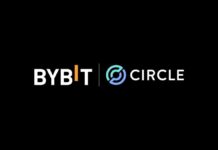
The application is reported as filed on February 7, 2020, and the invention is described as, “A voting system that can use the security of blockchain and the mail to provide a reliable voting system“. A registered voter receives a computer readable code in the mail and confirms identity and confirms correct ballot information in an election. The system separates voter identification and votes to ensure vote anonymity, and stores votes on a distributed ledger in a blockchain.”
The Patent is filed under Patent Number 20200258338 and claims:
1. A voting system comprising: a blockchain access layer configured to: receive input from a user operated mobile computing device, the input comprising a computer readable code scanned from a physical ballot, ballot selections, and an electronic signature; and receive input from an election official system, the input comprising a ballot and an election identifier; a first database in communication with the blockchain access layer, the first database configured to receive and store the ballot selections and the electronic signature from the blockchain access layer; a second database in communication with the blockchain access layer, the second database configured to: receive a vote identification from the blockchain access layer, the vote identification generated by the blockchain access layer in response to receive the ballot selections and electronic signature from the mobile computing device; store a first pointer to a location of the ballot selections in the first database; and store a second pointer to a location of the electronic signature in the first database; and a blockchain database configured to receive the vote identification from the second database and to receive the ballot selections from the blockchain access layer, wherein the block chain database receives the vote identification and the ballot selections when the block chain access layer receives an electronic signature confirmation from the election official system.
2. The voting system of claim 1, wherein the ballot selections and the electronic signatures are stored in separate structures in the first database.
3. The voting system of claim 2, wherein the first database has no referential data associating the ballot selections with the electronic signatures stored in the separate structures in the first database.
4. The voting system of claim 1, wherein the vote identification is a random alphanumeric string for tracking the instance of a vote.
5. The voting system of claim 1, wherein the electronic signature is an object bitmap created within a voting application on the user operated mobile computing device.
6. The voting system of claim 1, wherein the election identifier identifies a particular election.
7. The voting system of claim 1, wherein the blockchain access layer is further configured to receive a voter identification from the user operated mobile computing device, the voter identification identifying a unique user registered with the election official system.
8. The voting system of claim 1, further comprising a verification contract database, and wherein the blockchain access layer comprises a verification service module, wherein the verification service module is configured generate a hash of the ballot selections and the electronic signature received in the blockchain access layer, and to send the hash of the ballot selections and the electronic signature to the verification contract database.
9. The voting system of claim 8, wherein the blockchain access layer is further configured to send the hash of the ballot selections and the electronic signature to the user operated mobile computing device or to the election official system.
10. The voting system of claim 1, wherein the computer readable code includes at least one of a ballot identifier, an election identifier, and a voter identifier, and wherein the blockchain access layer authorizes the mobile computing device access to an electronic ballot based on the ballot identifier, election identifier, or the voter identifier.
11. A voting method comprising: receiving, in a blockchain access layer, input from a user operated mobile computing device, the input comprising a computer readable code scanned from a physical ballot, ballot selections, and an electronic signature; receiving input from an election official system, the input comprising a ballot and an election identifier; receiving, in a first database, the ballot selections and the electronic signature from the blockchain access layer; receiving, in a second database, a vote identification from the blockchain access layer, the vote identification generated by the blockchain access layer in response to receiving the ballot selections and electronic signature from the mobile computing device; storing, in the second database, a first pointer pointing to a location of the ballot selections in the first database; storing, in the second database, a second pointer pointing to a location of the electronic signature in the first database; and receiving, from the election official system, confirmation of the electronic signature; transmitting, to a blockchain database, the vote identification from the second database and the ballot selections corresponding to the vote identification based on the first pointer; and storing, in the blockchain database, the ballot selections.
12. The voting method of claim 11, wherein storing the ballot selections and the electronic signatures in the first database comprises storing the ballot selections and the electronic signature in separate structures in the first database.
13. The voting method of claim 12, wherein the first database has no referential data associating the ballot selections with the electronic signatures stored in the separate structures in the first database.
14. The voting method of claim 11, wherein the vote identification is a random alphanumeric string for tracking an instance of the ballot selection.
15. The voting method of claim 11, wherein the electronic signature is an object bitmap created within a voting application on the user operated mobile computing device.
16. The voting method of claim 11, wherein the election identifier identifies a particular election.
17. The voting method of claim 11, the method further comprising, receiving, from the user operated mobile computing device, a voter identification, the voter identification identifying a unique user registered with the election official system.
18. The voting method of claim 11, further comprising generating: in a verification service module, a hash of the ballot selections and the electronic signature received in the blockchain access layer; and sending the hash of the ballot selections and the electronic signature to the verification contract database.
19. The voting method of claim 18, further comprising, sending the stored hash of the ballot selections and the electronic signature to the user operated mobile computing device or to the election official system.
20. The voting method of claim 11, further comprising, authorizing, in the blockchain access layer, access to an electronic ballot based on the received computer readable code.
[newsletter_form lists="1"]










